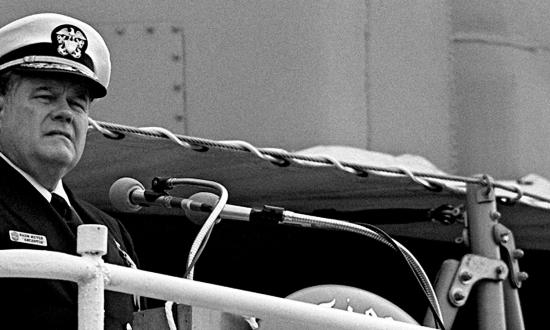Future Navy Vice Admiral Raymond E. Peet did a few months in fire control school after his graduation from the Naval Academy in 1942, then joined the USS Converse (DD-509) as a gunnery officer in the heat of the battle of the Pacific. “I was also officer of the deck,” he recalls in these edited excerpts from his 1984 oral history. “I loved that experience, maneuvering ships and changing formations. I had a good picture of relative movement with my math background and ability to work maneuvering boards.”
The Converse arrived in the Solomons in September 1943. Peet remembers:
Shortly after we got there, Captain Arleigh Burke was on the scene. We had heard a lot about him—that he was aggressive, gung ho, extroverted, reactive, and anxious to do something. We had taken a licking in the South Pacific in the first days. He was forming a squadron of new 2,100-ton Fletcher-class destroyers.
We joined up with him and used to make night runs up “The Slot”—the water between the two parallel strings of islands in the Solomons—and it was always hazardous. We would run darken ship and preferred black nights, because we had the advantage of radar and they did not. We would intercept barges and other small ship traffic, shoot them up, interdict the Japanese sea lanes.
On some of the engagements we did a lot of shore bombardment. We wore out one set of barrels in the Converse. I figured that it was more than 25,000 rounds I had been firing—an exciting life for a bachelor just out of the Academy.
We had five ships with us most of the time in Destroyer Squadron 23—“The Little Beavers”—and Burke did everything to make all the ships feel they were part of that team. He made sure the guns were aligned. We had calibration shoots, and we maneuvered at high speeds. We moved smartly, and we answered signals quickly. Everything was snap, snap. You’d have gone any place with that man. It was quite a thrill to be part of that team.
Peet earned a master’s degree in electrical engineering from MIT in 1948 before returning to destroyer duty, rising to command the USS Barton (DD-722) before rejoining Burke, now Chief of Naval Operations, as his aide in 1957. Later, he went on to learn nuclear power as a student under Vice Admiral Hyman Rickover in the nuclear reactors division, giving him the final skills he needed to take command of the Navy’s first and only nuclear-powered destroyer leader, the USS Bainbridge (DLGN-25) (the L in DLGN stood for “leader”).
There were so many special chapters in my career. Commanding the Navy’s first nuclear-powered destroyer was among them. The Bainbridge, some 9,000 tons and 560 feet long, was a very elegant ship. I was always disappointed she did not have a great deal of fighting capability, but the Bainbridge could travel forever, almost. The ship operated for at least three or four years without refueling. But armaments didn’t develop rapidly. Even to this day they don’t know what to put on those ships. They are arguing about Aegis, about various missiles. But they do not have a good weapon system to put on those ships.
The Bainbridge was a double-ended missile ship, with Terrier missiles fore and aft, unlike some of the ships today. It only had three-inch guns and some torpedo tubes. We did not have any hangar, but we could land a helicopter, good helicopter facilities on the fantail. The ship was designed more to be an antisubmarine and antiaircraft ship, not much of an offensive ship. This was contrary to my concept of its operations. Here you had a ship that was very, very capable of operating independently. If you are on independent operations, you’d better have firepower. I used to draw up schemes using these air defense missiles in a surface-to-surface mode so that it would give me some offensive power against surface ships.









